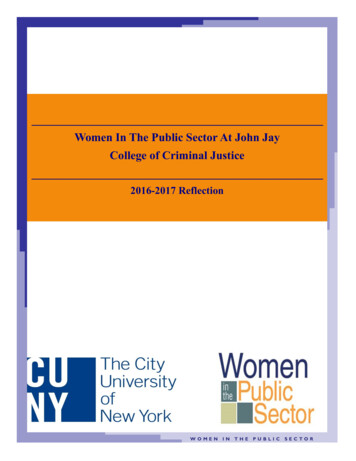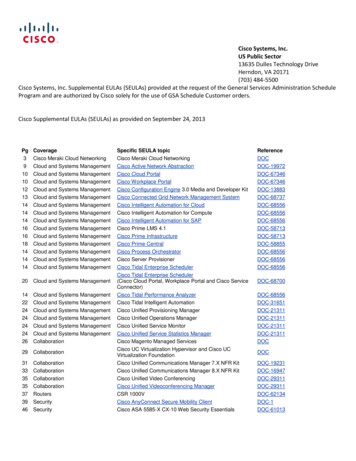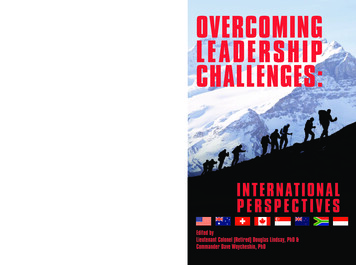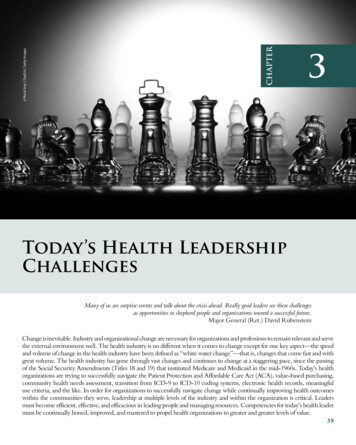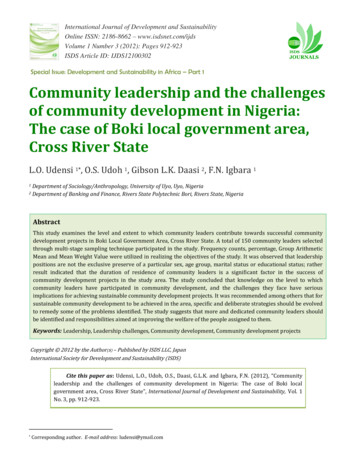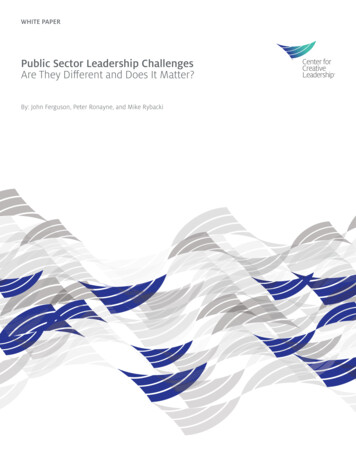
Transcription
WHITE PAPERPublic Sector Leadership ChallengesAre They Different and Does It Matter?By: John Ferguson, Peter Ronayne, and Mike Rybacki
ContentsIntroduction1Research1Overall Comparison2Managing & Motivating Subordinates4Organizational Operations & Performance5Balancing Multiple Work Priorities6Talent Management6Building & Leading Teams7Discussion & Conclusions8Appendix ALeadership Challenge Categories & Definitions9
IntroductionOn October 1, 2013, the United States federal government shut down after Congress failed to enact legislation appropriating funds for the new fiscal year. Routineoperations were curtailed, 800,000 federal employeeswere indefinitely furloughed, and another 1.3 millionwere required to report to work without known compensation. Regular government services did not resumeuntil October 17 when Congress passed and the president signed an interim appropriations bill.The government shutdown provided a dramatic example of the clash and collision of views surrounding therole of government and governance. Political leadersgrappled with fundamental questions concerning thecore functions, size, and funding of government. Despite their often diametrically opposed views, however,consistent calls could be heard from both sides of thepolitical aisle that “the government should be run morelike a business.”Implicit in this refrain is the assumption that business ismore efficient or effective than government. But are wecomparing apples to oranges? Certainly similarities ex-ist between the public and private sectors. For example,both are populated with organizations of diverse sizes,budgets, and missions. Nonetheless, major differencesare readily apparent. Private sector organizations usually focus on profits and shareholder value, and operate within a business or entrepreneurial framework.Public sector organizations typically focus on regulatoryimplementation of legislation and service delivery tocitizens, and operate within a unique constitutionalframework founded upon the separation of powers ofthe branches of government.Whether one sector is more or less efficient thananother is best left to economists and politicians to deliberate, but the larger question comparing the publicto the private sector does raise important issues aboutthe nature of leadership. Are there different challengesassociated with leading in the public vs. private sector?If so, do those differences alter the skills and behaviorsrequired for good leadership? How might these differences impact leader development? Answering thesequestions might benefit leaders in both sectors.ResearchThe Center for Creative Leadership (CCL ) routinelyasks participants in its Leadership Development Program,targeted to leaders of managers, and Leadership at thePeak program, targeted to enterprise leaders, to nametheir three most important leadership challenges. Program participants come from all sectors of the economyincluding business, government (both civilian andmilitary), education, and nonprofit organizations. Forthis paper, we content-analyzed written responses fromalmost 1,500 U.S. federal government civilian leadersand a sample of more than 500 private sector businessleaders who attended these two programs over the pastfive years. While the results are only applicable to U.S.federal civilian leadership, we feel that these experiences might also be familiar to state and local government leaders.This data provides rich insights into the similarities,differences, and critical nuances of public vs. privatesector leadership. And indeed, the story is one of nuance. As this paper highlights, leaders from both sectorsname similar leadership challenges and prioritize themin parallel for the most part, but the unique setting andcontext found in the public sector—very much definedby the Constitution—leads to subtle, but very real andnoteworthy differences. 2014 Center for Creative Leadership. All rights reserved.1
Overall ComparisonThe participants’ written responses to the question “What are your most important leadership challenges?”were analyzed and sorted into 17 categories (detailed explanations of each category are in Appendix A). Theoverall results are shown in the graph below:3.3.07Organizational GrowthBusinessGov’t0.81.2Work/Life Balance1.42.4Interpersonal Conflict2.53.0Creating/Changing CultureBuilding/Leading a Team2.93.3Strategic Issues2.53.55.13.9Develop Agility/Role Transition2.74.2Leading/Managing Org ChangeMiscellaneous0.84.6Leading a Team in a Context of Change4.94.85.76.4Influencing8.07.0Boundary Spanning6.67.9Talent Management9.67.8Balancing Multiple Work Priorities11.29.7Organizational Operations & Performance18.014.9Personal Leadership12.015.2Managing & Motivating Subordinates05Note: Percentages based upon the entire public or private sector sample population.2 2014 Center for Creative Leadership. All rights reserved.101520
The results on the left reveal that leaders in boththe public and private sectors cite the same sevenmost frequently reported challenges with slightdifferences in prioritization. Managing and Motivating Subordinates is the top challenge reportedby government leaders and the second listed bybusiness leaders. Personal Leadership earns thetop spot for business. Both groups cite Organizational Operations & Performance challengesin third place, followed with slight differences inprioritization by Balancing Multiple Work Priorities, Talent Management, Boundary Spanning,and Influencing.The written responses explain major differencesin prioritization. For government leaders, Managing and Motivating Subordinates takes on additional importance due to unique environmentalfactors associated with government service. Forexample, the annual government budgetingprocess with constantly looming furloughs andshutdowns increases uncertainty. Governmentworkers, or “bureaucrats,” are regularly malignedboth privately and publicly, which can diminishemployee engagement. Special employee protections can make it difficult and laborious to changeemployee behavior or remove poor performers.And since the government sector is Baby-Boomerheavy, a significant percentage of employees arenearing retirement eligibility. These factors makeManaging and Motivating Subordinates (and tosome degree the Talent Management challenge)more pressing for public sector leaders, whileboth groups view the challenge of Personal Leadership similarly—skill deficits in communicating,planning, confidence, resilience, and emotionalregulation.Government and business leaders see Organizational Operations & Performance challengessomewhat differently. For government leadersit involves dwindling or uncertain financial andstaffing resources, calls for increased efficiencyto “do more with less,” and trying to collaborate within a constitutional system designed todisperse power and decision-making (this is alsothe major difference in the Boundary Spanningchallenge). For business leaders the issues tend tofocus on staying current with technology, adapting to new regulations and policies, and dealingwith organizational and market changes in arapidly evolving global economy.Public and private sector leaders both describetime management and prioritization as issuescentral to the problem of Balancing MultipleWork Priorities. Both groups also see the challenge of Influencing very similarly.But the similarities and differences at this macrolevel do not tell the whole story. Some categoriesare quite large and contain multiple aspects ofleadership challenges that reveal important nuances. In the sections that follow we break downthe largest categories into their component partsto show additional detail behind the leadershipchallenges reported by government and businessleaders. Let’s explore some of the most illuminating categories in more detail. 2014 Center for Creative Leadership. All rights reserved.3
Managing & Motivating SubordinatesThis primary category comprises four subgroups—Motivating, Developing, Managing (general)and Problem Subordinates—shown in the following table. The numbers represent the percentage of the whole sample (N 1448 for government, N 531 for business) who chose that subgroup. For example, 6.9% represents the percentage of all government employees sampled whocited Motivating Subordinates as a key challenge.MANAGING SUBORDINATESBusinessGov’t2.72.74.92.8DEVELOPING SUBORDINATES0.43.1PROBLEM SUBORDINATES3.76.9MOTIVATING SUBORDINATES012345678Note: Percentages based upon the entire public or private sector sample population.4 2014 Center for Creative Leadership. All rights reserved.
Within its primary category, Motivating is the mostfrequently cited challenge for government leaders. Forthem the issue seems more difficult because employeesmust assume greater workloads in the face of decliningresources without the benefit of commensurate rewardsfor performance improvement or excellence. Motivating also surfaces as getting employees to “own” theirjobs or take initiative. Though Motivating is the secondhighest subcategory for business leaders, they cited italmost 50% less than their government counterparts.While motivating subordinates in either sector mightinvolve similar strategies and tactics, the context of aresource constrained and closed-system governmentenvironment produces unique challenges distinct from apotentially performance-based and incentive-rewardedbusiness context.Developing Subordinates is the most frequently citedchallenge for business leaders. Business respondents often discuss the reasonable need to prepare and developjunior colleagues for the next level of responsibility.For their government counterparts, however, dealingwith Problem Subordinates—an issue barely cited bybusiness leaders—drains attention from developinghigh potentials. Many government leaders mention thedifficulty, complexity, and lengthy process involved inremoving employees for other than illegal or unethicalacts. Similarly, government managers feel they can dolittle to correct performance issues when employees failto cooperate. These issues reflect the carefully structured and regulated process for firing and hiring government employees.Organizational Operations & PerformanceIn this primary category, the impact of governmentresource constraints is clearly evident. Budget is by farthe key operational leadership challenge with Resources,Increasing Efficiency, and Manpower Shortages all rankedhighly. The government’s limited and likely shrinking fiscal resources define the public sector leadership landscape.For private sector leaders, the challenges associated withresources are much less pronounced. In fact, the Miscellaneous subcategory is the most frequently mentioned,suggesting business leaders experience a more heterogeneous set of operational challenges. These eclecticissues range from maintaining continuous improvementprocesses and instituting enterprise-wide project management to raising the bar on customer care and meetingregulatory requirements.0.60.5BUREAUCRATIC ENVIRONMENT4.00.6MISCELLANEOUS0.21.5MANPOWER SHORTAGEBusinessGov’t1.21.7INCREASING 3.544.5Note: Percentages based upon the entire public or private sector sample population. 2014 Center for Creative Leadership. All rights reserved.5
Balancing Multiple Work PrioritiesBusinessGov’t0.10.6STAYING OUT OF DETAILSVOLUME OF WORK1.81.2TIME MANAGEMENT1.82In the context of increasingworkloads, leaders in bothsectors identify their top challenge as Setting and BalancingPriorities. Time Management isa close second for both groupsas well, followed by Volume ofWork. It seems that the environment in which leaders operatehas no major effect on how theydescribe this challenge. Setting,balancing, and shifting prioritiesin a high pressure environmentis difficult for leaders across sectors.2.92.7SETTING/BALANCING PRIORITIES00.511.522.533.5Note: Percentages based upon the entire public or private sector sample population.Talent Management0.20.1CREATING HR POLICY/PROGRAMSBusinessGov’t1.00.5EMPLOYEE ENGAGEMENT/MORALE0.20.6RESOURCE/POLICY SSION PLANNING/LEADER 11.522.533.544.5Note: Percentages based upon the entire public or private sector sample population.While the top two subcategories reflect the importanceof hiring and preparing organizational talent in both thepublic and private sectors, the constrained resource environment and structured HR policies of government makethis a bit more challenging for government leaders. TheGenerational/Diversity differences could be an outcome6 2014 Center for Creative Leadership. All rights reserved.of hiring philosophy: business tends to hire for cultural fitwhile government wants to reflect its varied constituency.Given the government environment challenges previously mentioned, it is surprising that business leaders citeEmployee Engagement/Morale as a bigger challenge thantheir government counterparts.
Building & Leading TeamsEMPOWERING A TEAMBusinessGov’t00.30.80.6STARTING/MERGING A TEAM0.41.0DEVELOPING A TEAM1.61.5LEADING A TEAM00.20.40.60.811.21.41.61.8Note: Percentages based upon the entire public or private sector sample population.Though the Building and Leading Teams category was cited as a challenge only about 3% of thetime across both sectors, a few interesting observations bear mention. Both government andbusiness leaders agree that Leading a Team is an important challenge. However, business leaders cite Starting or Merging a Team as their second most frequent challenge while governmentleaders felt that Developing a Team is more often a challenge. These findings may speak to thedifferent environments in which teams operate in each sector. 2014 Center for Creative Leadership. All rights reserved.7
Discussion & ConclusionsIn response to the question posed in this paper’s title—Public sector leadership challenges: Are they differentand does it matter?—the answer is perhaps best capturedby the phrase: “Yeah, sort of.” When first looking at theprimary category data, it might appear that differences between the public and private sector exist, but are minimal.That seems reasonable. After all, leadership in any sectorinvolves leading people who, regardless of sector, concomitantly share both universal human traits and unique individual differences. Deeper understanding of the subcategory data, however, reveals that more nuanced differencesdo exist. The environment of government, especially theconstitutional structure and financially constrained contextof the U.S. federal government, does appear to changesome of the challenges faced by those leaders.Do these differences alter how public sector leaders shouldbehave, the skills they need, and the development necessary to meet those challenges? Probably. Without thebenefit of significant financial incentives and quick meritpromotions, motivating government employees may require leaders to incorporate different strategies to inspiresuperior performance. Without access to additional resources, even when unit performance or challenges meritthose investments, leaders may need to collaborate evenmore intently and effectively with peers to accomplish themission. And once these skills and behaviors are identified,how can government instill them in leaders through systemic development, especially in the resource constrainedenvironment that is causing some of these challenges inthe first place?Leading is challenging in any environment. Leading in thepublic sector has some subtle, but noteworthy, additionalchallenges that require targeted leadership skills and development. With this knowledge, we can all better appreciate and serve those who serve us all.Appendix ALeadership Challenge Categories & DefinitionsBalancing Multiple Work Priorities: Challengeshaving to do with time management, volume ofwork, delegating, or setting prioritiesBoundary Spanning: Challenges having to dowith the need to or the difficulty of crossing hierarchical, functional, organizational, geographic,generational, cultural or other boundariesBuilding/Leading a Team: Any challenge having to do with creating a new team, integratingpeople into an existing team or combining teams,or improving team processCreating, Changing, or Maintaining a Culture:Challenges that specifically have to do with leading or managing a culture change in the organizationInfluencing: Challenges having to do with managing up, leading without authority, inspiring others, negotiation, or getting buy-in for one’s ideas/plans8 2014 Center for Creative Leadership. All rights reserved.Interpersonal Conflict with Peers or Superiors:An unresolved disagreement of a negative naturethat is personally concerning or impactful to theleader and involves a peer(s) ora superior(s)Leading a Team in a Context of Change:Challenges having to do with helping otherswith a unit or team to understand and cope withchange, redesigning group processes or policiesdue to change, coping oneself with crisis whilealso leading others through itLeading/Managing Organizational Change:Being accountable for leading or managing a major organization-wide change or aspects of thatchange, or working inside unhealthy culture
Appendix A continuedMaking a Role Transition: Challenges having to dowith the developmental agility required in successfully moving into a new job, a new department, anew organization; moving into or out of an assignment or sector; taking on additional responsibilitiesor dealing with uncertainty as a result of absence ofdirect bossManaging & Motivating Subordinates: Challengesrelated to managing, motivating, or developingothers, typically subordinates; dealing with problemsubordinates/performance issuesOrganizational Growth: Challenges that come withgrowth or lack of growthOrganizational Operations & Performance: Operational challenges such as dealing with budget cutsin a context of rising demand for services, the needto create greater group or organizational efficiency,working in a context of continuous change, dealingwith bureaucracy, increasing organizational performancePersonal Leadership Development: Challengesrelating to needs for personal and/or leadershipdevelopment, new awareness of own strengths anddevelopment needs, or self-management issuesStrategic Issues: Strategic leadership challengeshaving to do with vision, mission, broad environmental factors that impact an organization, or strategic planningTalent Management: Developing or implementingHR systems and processes or dealing with humanresource related issues and problemsWork/Life Balance: Struggling with decisions orcompeting demands and opportunities coming fromvarious parts of one’s life and/or personal needsAbout the AuthorsJohn Ferguson is the America’s Director of VerticalMarkets for the Center for Creative Leadership (CCL ),responsible for business, research, and educationalgoals across major industry sectors to include government, healthcare, pharmaceuticals, legal, financialservices, and energy. Prior to joining CCL, John spentover 20 years in military, government, higher education, and corporate leadership positions while livingand working in Iraq, Afghanistan, Pakistan, Germany,Korea, the Philippines, and the U.S. John holds an MBAfrom Duke University, a BS in Engineering from the U.S.Military Academy at West Point, and is completing aPhD in Economics. He is certified in executive coaching,psychometric assessments, facilitation and simulationmethodologies, and is a Six Sigma Black Belt with Leanand DFSS.Peter Ronayne, PhD, is a Senior Faculty member at theCenter for Creative Leadership where he designs anddelivers open-enrollment and custom programs witha focus on public sector leadership and organizationaldevelopment. Prior to joining CCL, Peter spent 15 yearsas a dean and senior faculty member at the FederalExecutive Institute (FEI) in Charlottesville, VA, where hedirected the flagship Leadership for a Democratic Society program and cofounded the institute’s program onneuroscience and leadership. Peter holds a PhD fromthe University of Virginia and a BS from GeorgetownUniversity.Mike Rybacki is a U.S. Army Infantry Captain, selectedto serve as a leadership and management instructorin the Department of Behavioral Science and Leadership, United States Military Academy at West Point.Mike served as an infantry platoon leader in the 82ndAirborne Division and an infantry company commanderin the 3rd Infantry Division, leading both a platoon inAfghanistan and a company in Iraq. He is currently anMBA candidate at Duke University, where he is alsoteaches as a Visiting Assistant Professor in the Duke/NCCU ROTC Detachment. Mike earned a BS in SystemsEngineering from the United States Military Academy. 2014 Center for Creative Leadership. All rights reserved.9
The Center for Creative Leadership (CCL ) is a topranked, global provider of leadership development.By leveraging the power of leadership to drive resultsthat matter most to clients, CCL transforms individualleaders, teams, organizations, and society. Our array ofcutting-edge solutions is steeped in extensive researchand experience gained from working with hundredsof thousands of leaders at all levels. Ranked amongthe world’s Top 10 providers of executive education byBloomberg Businessweek and the Financial Times, CCL hasoffices in Greensboro, NC; Colorado Springs, CO; SanDiego, CA; Brussels, Belgium; Moscow, Russia; AddisAbaba, Ethiopia; Johannesburg, South Africa; Singapore;Gurgaon, India; and Shanghai, China.CCL - Americaswww.ccl.org 1 800 780 1031 (U.S. or Canada) 1 336 545 2810 (Worldwide)info@ccl.orgGreensboro, North Carolina 1 336 545 2810Colorado Springs, Colorado 1 719 633 3891San Diego, California 1 858 638 8000CCL - Europe, Middle East, Africawww.ccl.org/emeaCCL - Asia Pacificwww.ccl.org/apacBrussels, Belgium 32 (0) 2 679 09 10ccl.emea@ccl.orgSingapore 65 6854 6000ccl.apac@ccl.orgAddis Ababa, Ethiopia 251 118 957086LBB.Africa@ccl.orgGurgaon, India 91 124 676 9200cclindia@ccl.orgJohannesburg, South Africa 27 (11) 783 4963southafrica.office@ccl.orgShanghai, China 86 182 0199 8600ccl.china@ccl.orgMoscow, Russia 7 495 662 31 39ccl.cis@ccl.orgAffiliate Locations: Seattle, Washington Seoul, Korea College Park, Maryland Ottawa, Ontario, CanadaFt. Belvoir, Virginia Kettering, Ohio Huntsville, Alabama San Diego, California St. Petersburg, FloridaPeoria, Illinois Omaha, Nebraska Minato-ku, Tokyo, Japan Mt. Eliza, Victoria, AustraliaCenter for Creative Leadership and CCL are registered trademarks owned by the Center for Creative Leadership. 2014 Center for Creative Leadership. All rights reserved.3.14
the key operational leadership challenge with Resources, Increasing Efficiency, and Manpower Shortages all ranked highly. The government’s limited and likely shrinking fis-cal resources define the public sector leadership land-scape. For private sector leaders, the challenges associated




